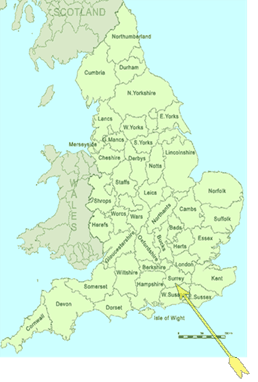
Grapes
100% Seyval Blanc
Yes, you are indeed forgiven for never having heard-of/tasted Seyval Blanc. The reason this French hybrid grape is starting to see a rise in popularity in English vineyards (as well as in New York and Canada), is that it isn’t opposed to a little cold weather (something which England does so well), since it buds and ripens early.
Facts
- The time is currently 8:28am GMT and I’m headed back to the U.S., after an impromptu visit to my family in West Yorkshire (Northern England). I’m sat in terminal 3 of Manchester Airport, having just finished a full English breakfast, and am now staring out of the window at the rain hitting the runway tarmac, with my laptop rested on my knees as I contemplate this review…
This is my first-ever English wine review, but not for want of trying to review one earlier might I add! Last year (2011), when I was back in the U.K. visiting family, I had attempted to pickup a bottle of English wine, any English wine. I tried large grocery stores, small wine retailers, farm stores, organic food shops, all to no avail!
This time around, I managed to get my hands on this bottle of Denbies “Whitedowns” Cuvée NV Sparkling from the York Food and Drink Festival. With that said, it was still the only English wine they had available in the whole festival!
So…in my best Yorkshire accent… sit thissen dahn an’ al tell thee all abart it!
- The Denbies is the currently largest vineyard in the United Kingdom; however the honor of largest winery goes to Chapel Down in Kent, this mainly due to the fact they buy in a substantial quantity of grapes. Denbies’ wines use only estate-grown grapes. They never buy to meet their needs…at least…not at the moment….
- Interestingly, because the Seyval Blanc variety has non-vitis vinifera origins (the most common genetic strain of grapevine) it is actually banned by the EU for use in “quality” wine production. Therefore, it couldn’t be used in the AOC or VDQS wines of France, the DOCG or DOC wines of Italy, the QbA or QmP wines of Germany, or the DO/DOCa wines of Spain etc.
- The Denbies Estate has received a lot of harsh criticism in the past regarding the quality of its wine; but luckily for them, things seem to be slowly on the up-and-up! With a little advice from German winemakers, and a switch in the planted grape varieties, the winery has gone from strength to strength, and the property now reportedly receives more than 460,000 visitors each year! Not bad to say that England only has a population of 53 million.
- In 2009, the Denbies Estate was the location of the first-ever International Sparkling Wine Symposium.
 Place (click map for larger view)
Place (click map for larger view)
- If you thought that England was too cold for growing grapes, you’d be half right! England isn’t exactly known for its fine wine production, but thanks to a little global warming (allegedly), wine production has started increasing on the tiny island, with bubbly receiving the most positive reviews.
- Reportedly, over 80% of the wine made by the Denbies winery is sold through their tasting room.
- The Denbies Estate is comprised of 627 acres of land (around 1 sq. mile), with 200 of these acres being woodland, 265 acres being vineyards, with the property also being home to 10 estate houses.
- The cold weather is no doubt one of the largest problems which English vineyards have to overcome. It’s therefore vital that the grapes a winery chooses are capable of handling the generally mild year-round temperatures, as well as the harsh winter frosts. Thin skins and early ripening/budding are the keys to success i.e. no Cabernet, Merlot or Syrah.
- Another challenge faced by English vineyards are that the grapevines tend to yield very low quantities of grapes. Luckily for the Denbies Estate, they don’t have a problem moving their wine; although, when they first started out in 1986, they were reportedly more-or-less giving the wine away.
- Denbies Wine Estate is the largest vineyard in England representing over 10% of the plantings in the whole of the UK.

Taste
(In homage to my recent trip back home to my home in West Yorskhire, I’m going to do the tasting notes in a full-on Yorkshire accent):
Int’ glass, thas got a fairly typical Sham-pag-nay (Champagne) colour, all yella and golden-like. A right nice nose, wi’ lemon, crisp green pear and a little Digestive biscuit.
Ont’ palate: plenty a lemon, sour Granny Smith apple, gooseberry, and a touch of freshly baked Warburtons. Finish was short, and tighter than a duck’s arse.
Not an arf-bad attempt, but I still think thez some work left to do before us Brits start to give Johnny Foreigner a run for their money, ah’ll tell thi that fer nowt!
Pairing
Pair as you would a Brut Champagne: with light appetizers, Brie, manchego, gouda, white meats, creamy sauces, almonds, white-fruit-based desserts or simply as an aperitif.
Price
£19 ($30) – Available from Denbies Wine Shop.


